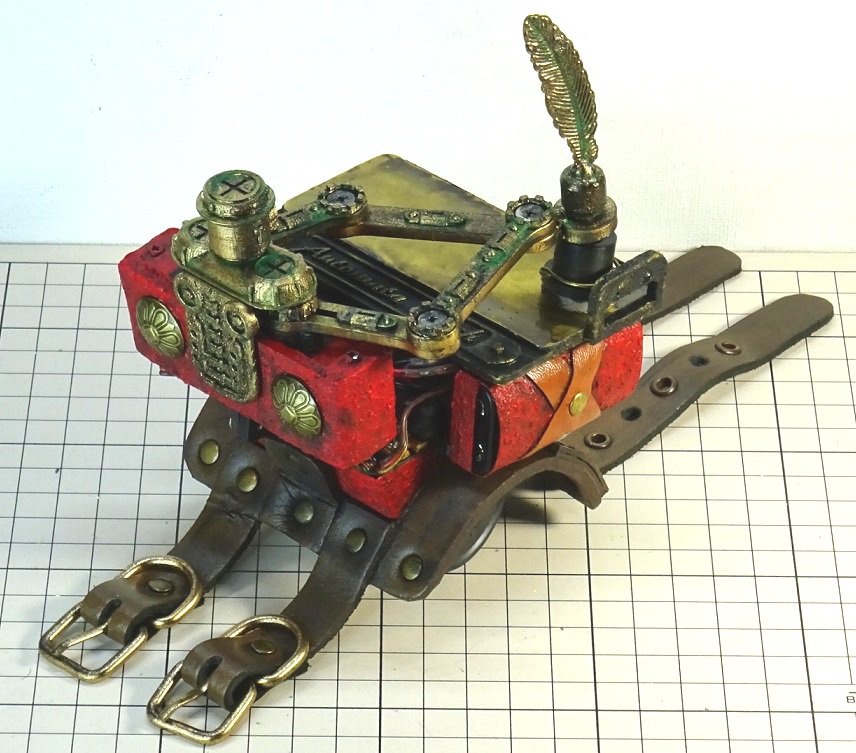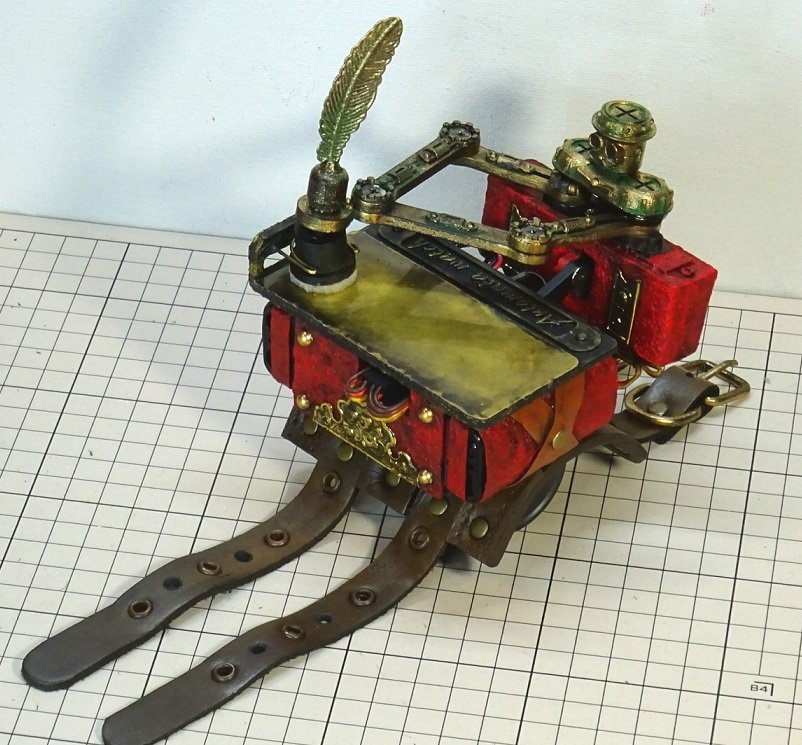









The Famous Holman Moody Mustang Raced By Cristobal “Batman” Galjuf In South America
from Tumblr https://somar78.tumblr.com/post/641325507964813312
What do you think of a watch that can continually write and erase the current time at any given time? Well, such a watch has been in existence since 2018. Designed by Japanese-based industrial designer FRISK_P, this is a spectacular Steampunk-inspired timepiece that will amaze anyone. It is called Automaton and justifies by name by continually writing and erasing the current time.
We have seen a good number of Steampunk-inspired masterpieces from FRISK_P, and we believe this is one of his very best creations in the last few years. It is difficult to identify what specifically inspired this unique masterpiece, but it is obvious that a lot of creativity went into making it a reality. It is something to celebrate, and we will discuss it briefly right here.
In terms of the design, Automaton doesn’t look like your average watch. A regular person will see it as an awkwardly book bracelet that is almost impractical to wear on any occasion at all. An informed person, on the other hand, will see it as a well-made steampunk timepiece that will find its place in history and serve as a reference point for other wonderful creations.

As mentioned already, this inspiring steampunk watch works by continually writing and erasing the current time. There is an antique-looking mechanism that picks up the golden quill from the inkpot and write on the face of the watch. The face of the watch doesn’t look anything like your regular watch dial; rather, it looks more like the top of a little rectangular box with a piece of antique paper on top.
After writing the time, the mechanism also picks up the quill (with no ink this time but a form of eraser) and erase the time in gentle, steady movements that will leave the surface very clean. The mechanism then dips the quill in the inkpot and writes the new current time. This process is continuously repeated to keep track of time.

To create this steampunk watch, FRISK_P, who is known for similar inventions, uses software like 3D CAD and Fusion 360 to design every part of it. To bring them into the real world, he used a 3D printer to print out the parts. The arts were masterfully assembled to look great and function perfectly.
To get the Automaton to work as it was designed to work, FRISK_P apparently used three servomotors and a microcomputer board. From the way the watch works, it is clear that these essential parts were properly sourced and are in great condition. It is expected that they will work optimally for years.

Steampunk is not just advancing in the literary world but also in the world of science and designs. It may appear that the retrofuturistic inventions that define this genre are not fully practical in today’s world, but no one can authoritatively predict what will become of them in the future. This steampunk watch designed by FRISK_P looks great and works pretty fine. It is as practical as some of the best steampunk inventions we have seen in recent times, and we believe it has earned its place in the future.
L’article PlotClock – A Steampunk Watch That Continually Writes and Erases the Current Time est apparu en premier sur Steampunk Tendencies.
Via Steampunk Tendencies https://steampunktendencies.comThere can be no denying that this is one of the most unique and unusual Panteras ever built by De Tomaso. It was a custom-built version of the De Tomaso Pantera GTS that had been tailor made for Tony Mantas, a personal friend of Alejandro De Tomaso, and a man who had very specific ideas about how he wanted his Pantera to look and perform.
Over the course of its fascinating life this car would live in Italy and Switzerland with journeys across Europe as far away as Sweden and possibly Greece.
The international man of mystery tour ended abruptly in 1985 when the car was confiscated by the Italian Polizia Stradale for using non-valid number plates.
When ordering his brand new De Tomaso Pantera GTS in the mid-1970s Tony Mantas supplied a thorough list of modifications he wanted done.
After it was delivered the car was returned to De Tomaso a number of times for further modifications – all of which seem to have made the car even more eye-catching that it had been previously.
Above Image: The unusual “Prototipo” De Tomaso Pantera GTS with its unusual wheel arches and front/rear spoiler is immediately recognizable.
When it was first ordered the car the internal build memo at De Tomaso read:
“No Pantera script on the side, vehicle as low as possible, dashboard in white leather, the area below the small gauges on the dashboard shall also be in white leather as well as the inside door covers. A “T” shall be fitted in the middle of the radiator. EE plates requested, no rear bumper, free flow exhaust system”
At some point the factory also fitted Group 4-style wheel arch flares, extended rocker panels, different alloy wheels, a deep front spoiler, and a Lancia Stratos-style roof spoiler.
De Tomaso kept an internal file on this car, including every invoice issued to Mantas, and also all the work done, how many hours it took and which mechanic did the work.
It’s believed that the car was returned to De Tomaso in 1977 for some work, during this time the engine was bored out to 7.0 litres. In 1978 Tony once again sent the car back to De Tomaso – he wanted a new red and white paint job with a see-through glass roof and a wooden interior.
At some point in the future the car was returned to its original specification.
The De Tomaso Pantera was in production from 1971 until 1992, a remarkably long life for a mid-engined supercar. The car was styled by American-born designer Tom Tjaarda and it used stamped steel unibody construction rather than the body on a steel backbone chassis-type construction used by the outgoing Mangusta model.
The Pantera GTS was a higher-performance version of the car first released in 1971.
It featured a high-compression Ford Cleveland V8 with solid lifters, a low-restriction performance exhaust, a forged aluminum alloy intake manifold, ventilated disc brakes, and a different steering rack.
Above Images: The car was photographed outside a restaurant in Stockholm, Sweden in September 1976.
The GTS was also fitted with larger wheels and tired which necessitated flared wheel arches, and they had black trim with GTS badging.
The car produced 330 bhp and it has a top speed of 160 mph, some later versions produced 355 bhp thanks to engines being supplied by Ford Australia.
This car’s history is notable for its seven year stay in police custody in Italy. Tony Mantas would never reacquire the car and it would stay in police custody until it was sold at a judicial auction to a gentleman in Bologna in late 1992.
Fortunately this new owner had the car totally restored and then maintained it in excellent condition. It remained in his ownership for 18 years between 1992 and 2010, and today the car is still accompanied by hundreds of documents outlining all the work that’s been done over the past 45+ years.
Tony Mantas’ former De Tomaso Pantera GTS is now due to cross the auction block with Artcurial in Paris on the 5th of February with a price estimate of €180,000 to €200,000.
If you’d like to read more about it or register to bid you can click here to visit the listing.
Images: 2021© Guido Bissantini courtesy of Artcurial
The post For Sale: Tony Mantas’ Unusual “Prototipo” De Tomaso Pantera GTS appeared first on Silodrome.
The Jensen Interceptor SP has the unusual distinction of being the quickest Interceptor ever built by Jensen in their factory near Birmingham.
The Interceptor is a car that needs no introduction, it’s famous for being a vehicle with British, Italian, and American DNA thanks to the fact it was designed by the Italians, powered by the Americans, and built/engineered by the Brits.
The handsome lines of the Interceptor have won it countless fans around the world since it was first offered to the public in 1966. The body was designed by the team at Carrozzeria Touring in Italy and the first bodies were built by Vignale before being sent back to England where they would be built into Interceptors.
All Interceptors (of this generation) were powered by American Chrysler V8 engines ranging in capacity from 383 cu. in. up to 440 cu. in., and some later Series 4 cars used the 360 cu. in. small block. The use of American V8s was relatively commonplace among low-volume European carmakers in the 1960s, 1970s, and beyond thanks to the fact that these engines were inexpensive, reliable, and easy to source parts for.
Jensen actually built two different cars called the Interceptor, the first was built from 1950 till 1957, and the second (of which this car is a member) was built from 1966 to 1976, with a couple of revivals in the decades after that resulted in a few dozen additional cars being built. Although the two Jensen Interceptors shared a name, they shared no parts or styling in common.
It was clear as the 1960s progressed that Jensen Motors needed a new flagship automobile. The 1950s styling queues of their previous models were no longer in fashion, the company needed something modern, fast, and elegant.
They turned to Touring who designed a startlingly attractive GT coupe using all-steel construction with a wrap-around rear glass panel that can be opened for easy access. As was common at the time the car uses independent front suspension with a live axle in the rear, Armstrong Selectaride dampers were used, and servo-assisted Dunlop discs were fitted at all four corners.
Jensen Motors had long used American engines, they would exclusively use Chrysler V8s in the Interceptor starting with the 383 V8 which sends power back through either a 4 speed manual or a 3-speed Torqueflite automatic.
The overwhelming majority of cars were fitted with the automatic gearbox, an indication that the Interceptor was intended as a luxurious grand tourer rather than a sports car. The interior of the car was well-appointed, with reclining seats, leather upholstery, electric windows, a stereo, walnut veneer trim, a wood-rimmed steering wheel, and later cars could be ordered with power-steering and air conditioning.
Over the course of production almost 6,500 Interceptors were built, of these the fastest was the car you see here, the Jensen Interceptor SP. That “SP” in the name stands for “Six Pack”, a reference to the three twin barrel carburetors fitted to the 440 cu. in. V8.
In this configuration the engine produced 385 bhp – an astonishing figure for 1971 that eclipsed both the Ferrari Daytona with 352 bhp and the Lamborghini Miura P400SV with 380 bhp. Just 232 examples of the Interceptor SP were built and today they’re highly sought after by enthusiasts and collectors.
The car you see here is a 1973 Jensen Interceptor SP, its first owner took delivery in Germany and the car has remained there ever since – possibly because it’s the perfect autobahn vehicle.
The car is presented in excellent condition throughout with some light patina on the original leather interior. It has air conditioning, power windows, and automatic transmission, and even the original tool roll.
If you’d like to read more about it or register to bid you can click here to visit the listing on RM Sotheby’s. It’s due to cross the auction block on the 13th of February with no reserve.
Images: Stephan Bauer ©2020 Courtesy of RM Sotheby’s
The post Jensen Interceptor SP – The Fastest Road-Legal Car Ever Built By Jensen appeared first on Silodrome.